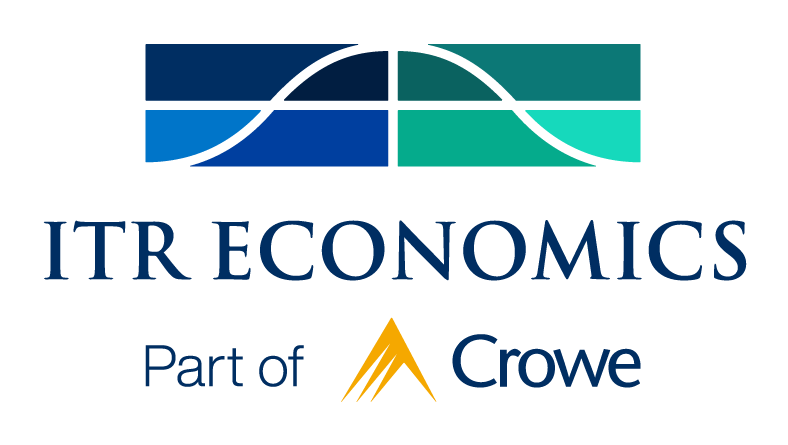March 31, 2025
- Home
- portfolio
- TrendsTalk
- March 31, 2025
NAVIGATING INFLATION AND MANAGING LABOR COSTS
This week on TrendsTalk, ITR Economist Taylor St. Germain discusses the impact of inflation on the Producer Price Index, as well as the importance to developing strategies to manage rising costs. Are you prepared to handle the upcoming inflationary pressures to your business? Tune in to TrendsTalk for the latest insights and actionable advice!

MEET YOUR HOST
Taylor St. Germain
As an experienced economist, Taylor St. Germain provides consulting services for small businesses, trade associations, and Fortune 500 companies across a spectrum of industries. His dynamic personality and extensive knowledge of economic trends and their business relevance are highly valued by clients and colleagues alike.
“Join me on the TrendsTalk podcast to explore the world of economics. Episodes offer insightful discussion and expert interviews. We cover relevant economic concepts in an accessible way. Whether you are a curious layperson or an industry professional, TrendsTalk is your go-to source for thought-provoking analysis and a deeper understanding of the economic forces shaping our world.”
The below transcript is a literal translation of the podcast audio that has been machine generated by Notta.
Hi everyone, my name is Taylor St. Germain with ITR Economics and welcome to this edition of TrendsTalk. We at ITR are your apolitical and unbiased source of economic intelligence and today I wanted to unpack inflation a little bit more.
Of course with all the geopolitical ongoings, the political ongoings in tariffs, there’s a lot of concerns as it relates to inflation and for good reason. One of the challenges with tariffs is we do often see some challenges on the inflation front. So I wanted to just provide an update with where we’re at. Now I really wanted to focus more on the producer side of things today.
Now in terms of the business environment, the producer price index is often a lot more applicable to us businesses from a pricing standpoint. Because what the producer price index measures is average selling prices of finished goods and services. And I covered this a bit last week in ITR Summit during my supply chain presentation that is still available via recording if you want to check that out. But what we are seeing is the early signs of some of this inflation pressure building on the producer side.
So as I’m sitting here talking with you today, the US producer price index is up 1.5% compared to the same period one year ago. And that index has entered accelerating growth. So what does that mean? Well that means the pricing pressures that we’ve already started to feel in early 2025 are expected to continue as we progress deeper into this year and for that matter deeper into the second half of this decade.
Now we are forecasting the US producer price index to finish 2025 at about 2.6 percent. So what does that mean? Well that means it is on average going to cost a business at least 2.6 percent more in 2025 to produce the goods and services that you provide compared to 2024. What that often means is price increases are likely going to be coming our way but are also likely going to be something that we’re looking to pass along to maintain our margin and it’s very important that we have a strategy for that.
Now there’s really only upside risks as far as I’m concerned to that forecast. We continue to see the Canada and Mexico tariffs moving if the administration moves forward with those. We just recently over the last couple of days heard the announcement of the automotive tariffs that are going in place. So there’s a lot of pricing pressure that can create even more inflation than our forecast is currently considering. So again, what I’m really urging everyone to do is have a plan in place to protect your margins, to pass along some of these price increases. But we also need to be thinking about the other side of this equation of how do we offset some of the higher costs coming our way? It’s very unlikely we’re going to maintain our margins from purely passing along price increases. Not everyone’s going to be receptive to that. So we need to also find ways to become more productive, to become more efficient. And these are trends that we’ve discussed on previous TrendsTalks, episodes, and it’s going to be so important because this higher inflation environment is really what we expect to characterize the next five years.
Now, I’d also urge you to understand where in the production process you fit because there is a big difference between commodities, unprocessed intermediate goods and processed intermediate goods. For example, if you’re in the unprocessed intermediate goods space, you’re going to deal with a lot more volatility as it relates to inflation rather than if you’re in the processed side or the commodity side. So it’s very important that you understand where you fit in to this inflation conversation because it can mean very different things. And that’s why we really need to take a very granular approach to your industry and what inflation is going to look like. And that’s something that we can help out with here at ITR, but I urge you to really take that approach.
Let me remind you that one of the other big inflationary pressures that we’re going to continue to deal with is labor costs. When I look at any labor benchmark, whether I’m looking at weekly earnings of manufacturing workers, weekly earnings of wholesale trade workers, or I’m just looking at median earnings overall here in the US, one thing that we notice is visually from a trend standpoint, we often see a much greater pace of increase following the pandemic, meaning our labor costs have accelerated much quicker than they have in the past few decades, really starting in the pandemic timeframe and continuing to where we are today. Again, we are projecting a 28% increase in the cost of labor all the way from now through the end of 2029, and it’s going to be very challenging to pass along all of those costs.
So again, we need to think about how are we automating? Are we adopting technology to drive our efficiencies forward? Are we innovating? Anything we can do to drive operational efficiencies in our business and offset these higher labor costs are going to be important. Again, when I take a step back, the key piece here is we are going to be dealing with higher inflation as businesses moving forward. And we need to make sure we’re having those discussions now on how we’re going to handle that so we can really benefit from the growth over the next five years.
I’ll remind everyone again, sales revenue, your top line numbers are very likely to enjoy five consecutive years of GDP growth that we have forecasted. But the question is, can you maintain the margin? Can you maintain the bottom line with all of these cost pressures that will be coming along with those five consecutive years of growth?
This is going to be a topic we’re discussing more and more. And again, many of these trends were covered in our ITR Summit last week, and a lot of great presentations there and the recordings are available if you happen to miss that.
I’m Taylor St. Germain with ITR Economics. Thanks for joining me on this episode of TrendsTalk. As a reminder, please like and subscribe to TrendsTalk wherever you listen to your podcast. And I look forward to seeing you on the next one. Take care for now.





